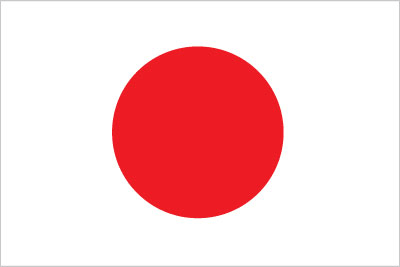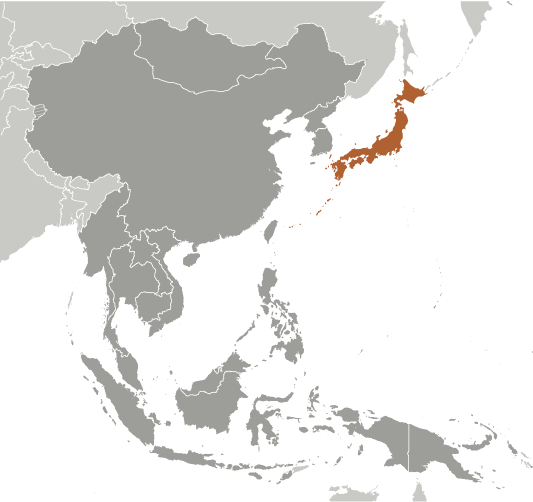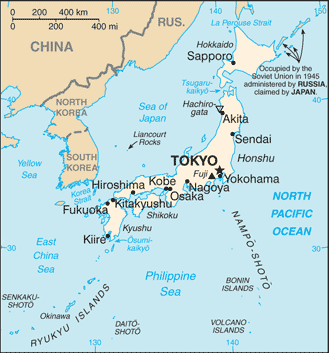|
Country name:
|

|
|
conventional long form: none
conventional short form:
Japan
local long form:
Nihon-koku/Nippon-koku
local short form:
Nihon/Nippon
|
|
|
Government type:
|

|
|
a parliamentary government with a constitutional monarchy
|
|
|
Capital:
|

|
|
name: Tokyo
geographic coordinates:
35 41 N, 139 45 E
time difference:
UTC+9 (14 hours ahead of Washington, DC during Standard Time)
|
|
|
Administrative divisions:
|

|
|
47 prefectures; Aichi, Akita, Aomori, Chiba, Ehime, Fukui, Fukuoka, Fukushima, Gifu, Gunma, Hiroshima, Hokkaido, Hyogo, Ibaraki, Ishikawa, Iwate, Kagawa, Kagoshima, Kanagawa, Kochi, Kumamoto, Kyoto, Mie, Miyagi, Miyazaki, Nagano, Nagasaki, Nara, Niigata, Oita, Okayama, Okinawa, Osaka, Saga, Saitama, Shiga, Shimane, Shizuoka, Tochigi, Tokushima, Tokyo, Tottori, Toyama, Wakayama, Yamagata, Yamaguchi, Yamanashi
|
|
|
Independence:
|

|
|
3 May 1947 (current constitution adopted as amendment to Meiji Constitution); notable earlier dates: 660 B.C. (traditional date of the founding of the nation by Emperor JIMMU); 29 November 1890 (Meiji Constitution provides for constitutional monarchy)
|
|
|
National holiday:
|

|
|
Birthday of Emperor AKIHITO, 23 December (1933)
|
|
|
Constitution:
|

|
|
3 May 1947
|
|
|
Legal system:
|

|
|
civil law system based on German model; system also reflects Anglo-American influence and Japanese traditions; judicial review of legislative acts in the Supreme Court
|
|
|
International law organization participation:
|

|
|
accepts compulsory ICJ jurisdiction with reservations; accepts ICCt jurisdiction
|
|
|
Suffrage:
|

|
|
20 years of age; universal
|
|
|
Executive branch:
|

|
|
chief of state: Emperor AKIHITO (since 7 January 1989)
head of government:
Prime Minister Shinzo ABE (since 26 December 2012); Deputy Prime Minister Taro ASO (since 26 December 2012)
cabinet:
Cabinet is appointed by the prime minister
(For more information visit the World Leaders website  ) )
elections:
Diet designates the prime minister; constitution requires that the prime minister commands parliamentary majority; following legislative elections, the leader of majority party or leader of majority coalition in House of Representatives usually becomes prime minister; the monarchy is hereditary
|
|
|
Legislative branch:
|

|
|
bicameral Diet or Kokkai consists of the House of Councillors or Sangi-in (242 seats - members elected for fixed six-year terms; 146 members in multi-seat constituencies and 96 by proportional representation) half elected every three years; and the House of Representatives or Shugi-in (480 seats - members elected for maximum four-year terms; 300 in single-seat constituencies; 180 members by proportional representation in 11 regional blocs); the prime minister has the right to dissolve the House of Representatives at any time with the concurrence of the cabinet
elections:
House of Councillors - last held on 11 July 2010 (next to be held in July 2013); House of Representatives - last held on 16 December 2012 (next to be held by 15 December 2016)
election results:
House of Councillors - percent of vote by party - DPJ 31.6%, LDP 24.1%, YP 13.6%, NK 13.1%, JCP 6.1%, SDP 3.8%, others 7.7%; seats by party - DPJ 106, LDP 84, NK 19, YP 11, JCP 6, SDP 4, others 12
House of Representatives - percent of vote by party (by proportional representation) - LDP 31.6%, DPJ 16.6%, JRP 22.2%, New Komeito 12.2%, Your Party 7.7%, TRP 3.9%, JCP 4.4%, others 0.56%; seats by party LDP 294, DPJ 57, JRP 54, New Komeito 31, Your Party 18, TPJ 9, JCP 8, others 4, independents 5
|
|
|
Judicial branch:
|

|
|
Supreme Court (chief justice is appointed by the monarch after designation by the cabinet; all other justices are appointed by the cabinet)
|
|
|
Political parties and leaders:
|

|
|
Democratic Party of Japan or DPJ [Banri KAIEDA]; Japan Communist Party or JCP [Kazuo SHII]; Japan Restoration Party or JRP [Shintaro ISHIHARA]; Liberal Democratic Party or LDP [Shinzo ABE]; New Komeito or NK [Natsuo YAMAGUCHI]; People's Life Party or PF [Ichiro OZAWA]; Social Democratic Party or SDP [Mizuho FUKUSHIMA]; Your Party or YP [Yoshimi WATANABE]
|
|
|
Political pressure groups and leaders:
|

|
|
other: business groups; trade unions
|
|
|
International organization participation:
|

|
|
ADB, AfDB (nonregional member), APEC, ARF, ASEAN (dialogue partner), Australia Group, BIS, CD, CE (observer), CERN (observer), CICA (observer), CP, EAS, EBRD, EITI (implementing country), FAO, FATF, G-20, G-5, G-7, G-8, G-10, IADB, IAEA, IBRD, ICAO, ICC (national committees), ICRM, IDA, IEA, IFAD, IFC, IFRCS, IGAD (partners), IHO, ILO, IMF, IMO, IMSO, Interpol, IOC, IOM, IPU, ISO, ITSO, ITU, ITUC (NGOs), LAIA (observer), MIGA, NEA, NSG, OAS (observer), OECD, OPCW, OSCE (partner), Paris Club, PCA, PIF (partner), SAARC (observer), SELEC (observer), SICA (observer), UN, UNCTAD, UNDOF, UNESCO, UNHCR, UNIDO, UNMISS, UNRWA, UNWTO, UPU, WCO, WFTU (NGOs), WHO, WIPO, WMO, WTO, ZC
|
|
|
Diplomatic representation in the US:
|

|
|
chief of mission: Ambassador Kenichiro SASAE
chancery:
2520 Massachusetts Avenue NW, Washington, DC 20008
telephone:
[1] (202) 238-6700
FAX:
[1] (202) 328-2187
consulate(s) general:
Atlanta, Boston, Chicago, Denver, Detroit, Agana (Guam), Honolulu, Houston, Los Angeles, Miami, Nashville (TN), New York, Portland (OR), San Francisco, Seattle
consulate(s):
Anchorage (AK), Saipan (Northern Mariana Islands)
|
|
|
Diplomatic representation from the US:
|

|
|
chief of mission: Ambassador John V. ROOS
embassy:
1-10-5 Akasaka, Minato-ku, Tokyo 107-8420
mailing address:
Unit 9800, Box 300, APO AP 96303-0300
telephone:
[81] (03) 3224-5000
FAX:
[81] (03) 3505-1862
consulate(s) general:
Naha (Okinawa), Osaka-Kobe, Sapporo
consulate(s):
Fukuoka, Nagoya
|
|
|
Flag description:
|

|
|
white with a large red disk (representing the sun without rays) in the center
|
|
|
National symbol(s):
|

|
|
red sun disc; chrysanthemum
|
|
|
National anthem:
|

|
|
name: "Kimigayo" (The Emperor"s Reign)
lyrics/music:
unknown/Hiromori HAYASHI
note:
adopted 1999; in use as unofficial national anthem since 1883; oldest anthem lyrics in the world, dating to the 10th century or earlier; there is some opposition to the anthem because of its association with militarism and worship of the emperor
|
|
|
|
|





 )
)



